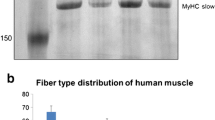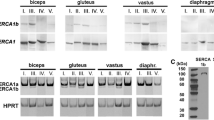Abstract
αKAP is a non-kinase product of a gene within α CaMKII gene, that anchors catalytic subunits to skeletal muscle sarcoplasmic reticulum. αKAP gene expresses two distinct mRNA transcripts by alternative splicing in rabbit fast muscle, rather than one, as an apparently fiber-type specific and species-specific property. We report on the expression profile of αKAP gene in fast and slow muscles of adult rats and in rabbit post-natal developing muscles, by RT-PCR analysis of muscle RNA, together with Western blot analysis of expressed αKAP protein isoforms. We show that αKAP isoform predominantly expressed in muscle of newborn rabbits, corresponds to the fast-adult isoform. In fast muscle, the transition from neonatal isoform to the common adult isoform takes place early after birth, and is never complete, unlike in slow muscle. Relevant to these findings, is the observation that neonatal/embryonic αKAP mRNA is highly expressed in rat myotubes grown in vitro. Together, our findings suggest that αKAP splicing pathways are primarily modulated according to muscle developmental stage.
Similar content being viewed by others
References
Bayer K-U, Lohler J and Harbers K (1996) An alternative, nonkinase product of the brain-specifically expressed Ca2+ /calmodulindependent kinase II a isoform gene in skeletal muscle. Mol Cell Biol 16: 29-36.
Bayer K-U, Harbers K and Schulman H (1998) αKAP is an anchoring protein for a novel CaM kinase II isoform in skeletal muscle. EMBO J 17: 5598-5605.
Bayer K-U and Schulman H (2001) Regulation of signal transduction by protein targeting: the case for CaMKII. Biochem Biophys Res Commun 289: 917-923.
Bayer K-U, DeKoninck P and Schulman H (2002) Alternative splicing modulates the frequency-dependent response of CaMKII to Ca2+ oscillations. EMBO J 21: 3590-3597.
Berchtold MW, Brinkmeier H and Muentener M (2000) Calcium ion in skeletal muscle: its crucial role for muscle function, plasticity, and disease. Physiol Rev 80: 1215-1265.
Black DL (2003) Mechanisms of alternative pre-messenger RNA splicing. Annu Rev Biochem 72: 291-336.
Brandl CJ, deLeon S, Martin DR and MacLennan DH (1987) Adult forms of the Ca2+-ATPase of sarcoplasmic reticulum. Expression in developing skeletal muscle. J Biol Chem 262: 3768-3744.
Breitbart R, Nguyen HT, Medford RM, Destree AT, Mahdavi V and Nadal-Ginard B (1985) Intricate combinatorial patterns of exon splicing generate multiple regulated troponin T isoforms from a single gene. Cell 41: 67-82.
Brini M, De Giorgi F, Murgia M, Marsault R, Massimino ML, Cantini M, Rizzuto R and Pozzan T (1997) Subcellular analysis of Ca2+ homeostasis in primary cultures of skeletal muscle myotubes. Mol Biol Cell 8: 129-143.
Damiani E and Margreth A (2000) Pharmacological clues to calmodulin-mediated activation of skeletal ryanodine receptor using [3H]-ryanodine binding. J Muscle Res Cell Motil 21: 1-8.
Damiani E, Sacchetto R and Margreth A (2000) Phosphorylation of anchoring protein by calmodulin protein kinase associated to the sarcoplasmic reticulum of rabbit fast-twitch muscle. Biochem Biophys Res Commun 279: 181-189.
Damiani E, Sacchetto R, Salviati L and Margreth A (2003) Two splice variants of CaMKII-anchoring protein are present in the sarcoplasmic reticulum of rabbit fast-twitch muscle. Biochem Biophys Res Commun 302: 73-83.
Fliegel L, Ohnishi M, Carpenter MR, Khanna VK, Reithmeier RAF and MacLennan DH (1987) Amino acid sequence of rabbit fasttwitch skeletal muscle calsequestrin deduced from cDNA and peptide sequencing. Proc Natl Acad Sci USA 84: 1167-1171.
Franzini-Armstrong C and Fischman D (1994) Morphogenesis of skeletal muscle fibers. In: Engel AG and Franzini-Armstrong C <nt>(eds.)</nt> Myology (pp. 74-96), McGraw Hill, New York.
Hudmon A and Schulman H (2002) Neuronal Ca2+ /calmodulindependent protein kinase II: the role of structure and autoregulation in cellular function. Annu Rev Biochem 71: 473-510.
Kelly AM and Rubinstein NA (1994) The diversity of muscle fiber types and its origin during development. In: Engel AG and Franzini-Armstrong C <nt>(eds.)</nt> Myology (pp. 119-133) McGraw Hill, New York.
Laemmli UK (1970) Cleavage of structural proteins during the assembly of the head of bacteriophage T4. Nature 277: 680-685.
Leberer E, Charuk J, Clarke D, Green N, Zubrzycka E and MacLennan DH (1989) Molecular cloning and expression of cDNA encoding the 53,000-dalton glycoprotein of rabbit skeletal muscle sarcoplasmic reticulum. J Biol Chem 264: 3484-3493.
Lowry OH, Rosebrough NJ, Farr AL and Randall RJ (1951) Protein measurements with the Folin phenol reagent. J Biol Chem 265: 10118-10124.
Pette D and Staron RS (1990) Cellular and molecular diversities of mammalian skeletal muscle fibers. Rev Physiol Biochem Pharmacol 116: 2-76.
Sacchetto R, Volpe P, Damiani E and Margreth A (1993) Post-natal development of rabbit fast-twitch skeletal muscle: accumulation, isoform transition and fibre distribution of calsequestrin. J Muscle Res Cell Motil 14: 646-653.
Sacchetto R, Damiani E and Margreth A (2002) Clues to calcineurin function in mammalian fast-twitch muscle. J Muscle Res Cell Motil 22: 545-559.
Saito A, Seiler S, Chu A and Fleischer S (1984) Preparation and morphology of sarcoplasmic reticulum terminal cisternae from rabbit skeletal muscle. J Cell Biol 99: 875-885.
Sanes JR and Lichtman JW (1999) Development of the vertebrate neuromuscular junction. Annu Rev Neurosci 22: 389-442.
Schiaffino S and Reggiani C (1996) Molecular diversity of myofibrillar proteins: gene regulation and functional significance. Physiol Rev 76: 371-423.
Schulman H and Braun A (1999) Calcium/Calmodulin-dependent protein kinases. In: Carafoli E and Klee C <nt>(eds.)</nt> Calcium as a cellular regulator (pp. 311-342), Oxford University Press, New York.
Sugai R, Takeuchi M, Okuno S and Fujisawa H (1996) Molecular cloning of a novel protein containing the association domain of calmodulin-dependent protein kinase II. J Biochem 120: 773-779
Author information
Authors and Affiliations
Rights and permissions
About this article
Cite this article
Sacchetto, R., Salviati, L., Damiani, E. et al. Post-natal developmental expression of αKAP splice variants in rabbit fast-twitch and slow-twitch skeletal muscle. J Muscle Res Cell Motil 25, 309–314 (2004). https://doi.org/10.1007/s10974-004-1685-0
Issue Date:
DOI: https://doi.org/10.1007/s10974-004-1685-0




